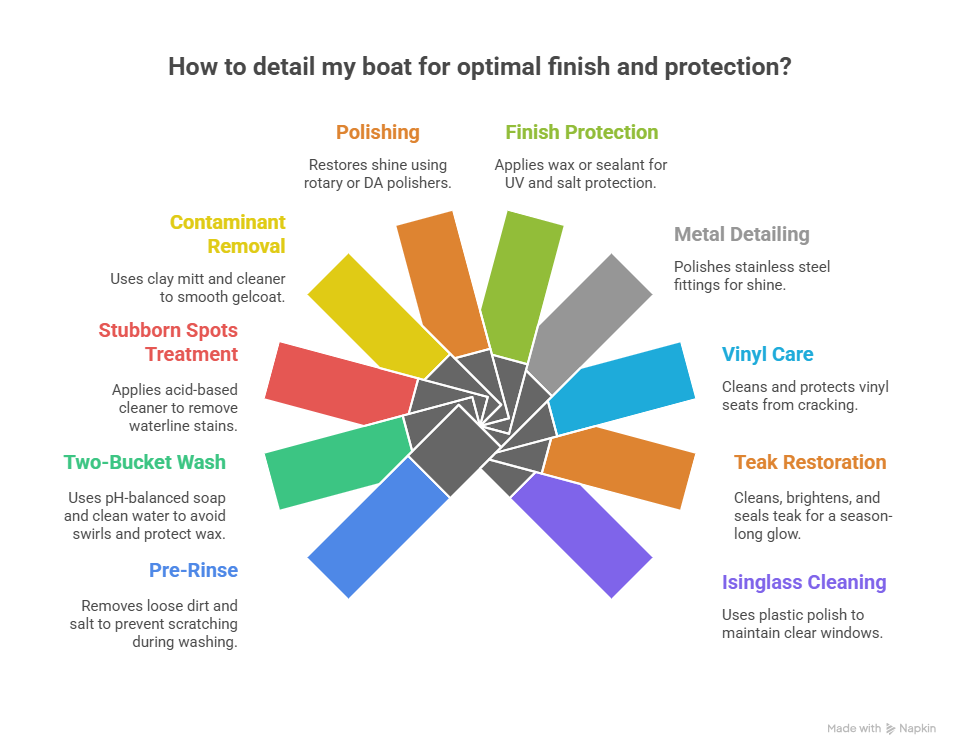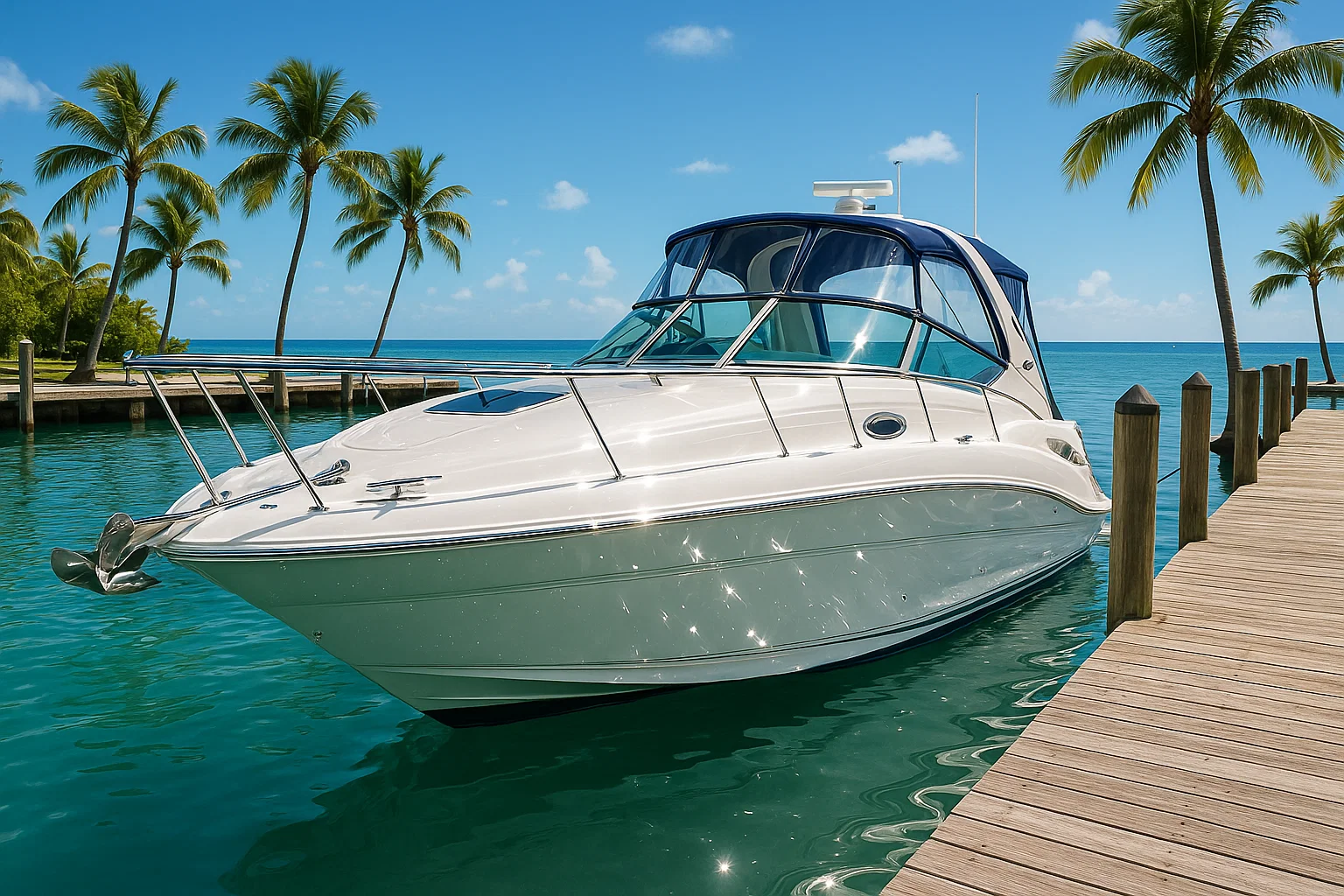I’ve been detailing boats in South Florida for 15 years, from Miami’s bustling Dinner Key Marina to the quiet docks of Key Biscayne. There’s nothing like seeing a weathered hull transform into a gleaming showpiece under your hands. Last June, a guy named Javier brought his 2022 Sea Ray 270 to my shop in Fort Lauderdale, complaining about a chalky gelcoat that looked like it hadn’t been touched since the showroom. A weekend of work—two-bucket washing, clay mitt decontamination, and a hybrid ceramic wax—had it sparkling like new, saving him $1,200 compared to a pro job. Here’s my step-by-step process to get your boat looking pristine without losing your sanity.
Table of Contents
Why Does My Boat’s Finish Look Dull?
Sun, salt, and grime are brutal on a boat’s gelcoat. I’ve seen brand-new yachts turn chalky after one Miami summer—UV rays oxidize the surface, and salt crystals grind in like sandpaper. A proper detail isn’t just cosmetic; it protects your investment from long-term damage. I learned this the hard way in 2010 when I skipped a wax job on my own Boston Whaler—ended up with a $2,000 gelcoat repair. This guide breaks down my system for a professional-grade finish, from washing to sealing.
What’s the Best Way to Start Detailing My Boat?
A flawless detail starts with a clean canvas. Last July, a client at Coconut Grove had waterline stains on her Grady-White 208 that wouldn’t budge with a quick rinse. Here’s how I tackle the foundation:
- Pre-Rinse: I use a pressure washer on low (1,500 PSI) to blast off loose dirt and salt from top to bottom. This stops you from rubbing grit into the gelcoat.
- Two-Bucket Wash: I fill one bucket with Star brite Marine Boat Soap—pH-balanced to cut salt without stripping wax—and another with clean water to rinse my microfiber mitt. This cuts down on swirls, which I’ve seen ruin a $500 detail job.
- Stubborn Spots: For waterline “beards,” I apply Marykate On & Off Hull Cleaner, let it sit for 3 minutes, scrub gently, and rinse. It’s acid-based, so I never let it dry.
This prep isn’t glamorous, but it’s the difference between a so-so job and a mirror finish.
How Do I Remove Invisible Contaminants from the Gelcoat?
Even after washing, tiny particles like rail dust or algae stick to the gelcoat, making it feel gritty. I learned this trick from a mentor, Ray, at Bahia Mar in 2012. I use a Nanoskin Fine Clay Mitt with Meguiar’s M67 Marine/RV One Step Cleaner as a lubricant. Glide it over a wet hull, and you’ll feel the surface go from rough to glass-smooth. For heavily oxidized boats, I skip claying—compounding takes care of those contaminants. Last month, I decontaminated a client’s Bayliner 285 at Stiltsville, and the wax bonded so well it lasted through a stormy August.
What Tools Should I Use for Polishing?
Polishing is where the shine comes back. In April 2024, a buddy’s Regal 28 Express looked like chalk until I hit it with the right gear. Here’s what I use:
- Rotary Polisher: A DeWalt rotary for heavy oxidation—cuts fast but needs skill to avoid holograms. I used it on a client’s weathered Viking 50, removing years of UV damage in 6 hours.
- Dual-Action (DA) Polisher: A Rupes LHR15 is my go-to for beginners or light scratches. It’s safer, with less heat, and perfect for most boats.
- Pads and Compounds: I start with 3M Marine Compound on a wool pad for deep defects, then switch to Meguiar’s M67 Polish with a foam pad for clarity.
Keep pads clean with a brush after each section—caked compound can scratch your work.
How Do I Restore a Deep, Glossy Finish?
Polishing is a two-step dance: cut, then refine. For Javier’s Sea Ray, I used a heavy-cut compound to erase oxidation, working 2’x2’ sections with slow, overlapping passes. Took me 4 hours to cover the hull. Then, I polished with a finer product to bring out a wet-looking gloss—another 3 hours, but worth it when he saw the reflection. For really bad boats, I’ve wet-sanded first (800-grit paper), but that’s pro-level stuff. A client in Key Biscayne tried it himself and removed too much gelcoat—cost him $3,000 to fix.
What’s the Best Way to Protect My Boat’s Finish?
After polishing, you need a shield against South Florida’s sun and salt. I’ve tested every wax out there, and here’s what works:
- Carnauba Wax: Gives a warm, deep shine but fades in 3 months. I used Collinite 925 on a client’s Boston Whaler last spring—looked great but needed reapplication by July.
- Synthetic Sealants: Meguiar’s M21 lasts 6+ months with solid UV protection. I applied it to a yacht at Dinner Key, and it held up through summer storms.
- Hybrid Ceramic Wax: Gtechniq Marine Ceramic Fast Coat is my favorite—easy to apply, beads water like crazy, and lasts 8 months. Saved a client $500 in re-waxing costs.
Apply with a DA polisher on low or a foam pad by hand. Thin coats only—too much product just makes buffing harder. Let it haze (10–15 minutes), then wipe with a microfiber towel.

How Do I Detail Metal, Vinyl, and Teak?
A boat’s not just its hull. Last summer, a client at Stiltsville was frustrated with foggy Isinglass and tarnished stainless on his Sea Ray 310. Here’s my approach:
- Stainless Steel: I use Flitz Metal Polish on a microfiber towel for rails and cleats. A drill with a polishing cone gets tight spots. Took me 30 minutes to make his fittings gleam.
- Vinyl Seats: Star brite Vinyl Cleaner and a soft brush keep seats supple. I follow with 303 Aerospace Protectant for UV defense—prevents cracking, unlike bleach.
- Teak: I clean with Star brite Teak Cleaner, brighten with their Teak Brightener, and seal with Semco Teak Sealer for a season-long glow. Gray teak on a client’s Hatteras took 2 hours to revive.
- Isinglass/Acrylic: Never use ammonia-based cleaners—they fog plastics permanently. I use Novus Plastic Polish #1 for crystal-clear windows.
Using the wrong product can cost hundreds—like the guy who used Windex on his Plexiglass and needed a $1,000 replacement.
Table: My Go-To Boat Detailing Tools
I put this table together from jobs I’ve done in South Florida:
| Tool/Product | Use Case | Cost | Availability |
|---|---|---|---|
| Star brite Marine Boat Soap | Two-bucket wash, safe for wax | $15 | Marine stores |
| Nanoskin Fine Clay Mitt | Decontaminating gelcoat | $25 | Online, Amazon |
| 3M Marine Compound | Removing heavy oxidation | $30 | Marine stores |
| Meguiar’s M67 Polish | Restoring glossy shine | $25 | Online, West Marine |
| Gtechniq Marine Ceramic Wax | Long-lasting UV protection | $50 | Specialty retailers |
| Flitz Metal Polish | Polishing stainless steel | $20 | Marine stores |
| 303 Aerospace Protectant | Protecting vinyl seats | $15 | Online, Amazon |
FAQ: Common Boat Detailing Questions
How Often Should I Detail My Boat?
I detail my Boston Whaler every 6 months—spring and fall—to keep it pristine. Wash monthly with a pH-balanced soap, decontaminate twice a year, and re-wax or seal annually. A client at Bahia Mar skipped this and paid $2,000 for gelcoat repairs. Check out Star brite’s maintenance kits for easy scheduling.
What’s the Best Soap for Boat Washing?
Star brite Marine Boat Soap is my go-to—it’s pH-balanced, cuts salt, and won’t strip wax. I used it on a Sea Ray 350 last June, and it cleaned without dulling the finish. Avoid dish soap; it’s too harsh. Pick it up at West Marine for $15.
Can I Detail My Boat Myself?
Absolutely, if you’ve got time and tools. I showed a buddy at Key Biscayne how to wash and wax his Regal 26 in a weekend—saved him $800. Start with a two-bucket wash and a DA polisher for beginners. Rent tools from marine shops if you don’t own them.
How Do I Remove Waterline Stains?
Use Marykate On & Off Hull Cleaner for that “boat beard.” Apply, wait 3 minutes, scrub, and rinse—worked like a charm on a Grady-White last summer. Don’t let it dry, or it’ll streak. Costs about $20 at West Marine.
Why Is My Gelcoat Still Gritty After Washing?
Invisible contaminants like algae or rail dust stick around. I use a Nanoskin Clay Mitt with lubricant—transformed a Bayliner’s hull in 30 minutes last month. Glide it over a wet surface, and it’ll feel smooth as glass. Get one for $25 online.
What’s the Difference Between Wax and Sealant?
Carnauba wax gives a warm shine but lasts 3 months; synthetic sealants like Meguiar’s M21 last 6+ months with better UV protection. I used Gtechniq Ceramic Wax on a yacht and it held up for 8 months. Sealants are pricier ($50) but worth it.
How Do I Keep My Vinyl Seats From Cracking?
Clean with Star brite Vinyl Cleaner and a soft brush, then apply 303 Aerospace Protectant for UV defense. I saved a client’s Sea Ray seats from cracking last year—cost $15 versus $500 for replacements. Avoid bleach; it dries out vinyl.
Conclusion
Detailing your boat isn’t just about looks—it’s about protecting your investment from South Florida’s brutal sun and salt. I’ve seen boats go from chalky wrecks to head-turners with a weekend of work. Follow my system: wash and decontaminate for a clean canvas, polish to restore shine, seal with a durable wax, and use surface-specific products for metal, vinyl, and teak. Last spring, I detailed a client’s Hatteras at Coconut Grove, and he’s still getting compliments. Grab your tools, pick a sunny weekend, and make your boat gleam—you’ll feel like you’re back on its maiden voyage.
Author Bio
I’m Alex, a 15-year marine detailing veteran in South Florida, with ABYC certification and 200+ boats polished to perfection. From Miami to Fort Lauderdale, I’ve tackled everything from Sea Rays to Vikings.


Leave a Reply